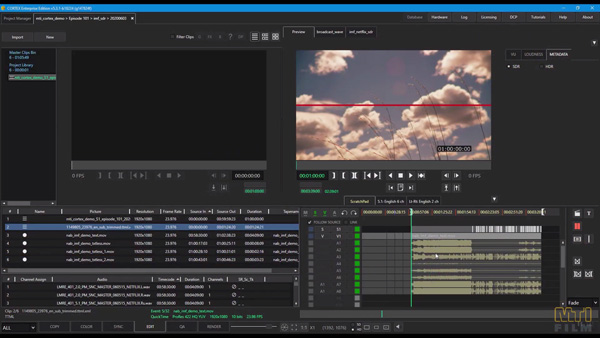MTI Cortex v5.5 Adds New AI Tools for Frame Rate Conversion and Up Resolution

MTI Film’s v5.5 update to the Cortex line of transcoding and workflow software includes two AI-driven options, MTai Frame Rate Conversion and MTai Super Resolution Uprez, applying artificial intelligence to two common tasks in order to speed up and improve results.
Cortex 5.5 also adds new or upgraded features to its core software that support new formats and delivery requirements, and address users’ set-to-screen workflow issues. Cortex supports productions, on set and in post, with tools for editing, colour, QA, monitoring renders and archive.
MTai Frame Rate Conversion improves on conventional frame rate conversion processes, which generally rely on duplicating or removing frames. The new approach uses machine learning to interpolate between frames, increasing or decreasing the frame rate without ghosting, stutter or distortion. MTI Film’s Director of Product Development Randy Reck is enthusiastic about the results. “The software analyses multiple adjoining frames for motion, background and foreground elements and produces a synthetic frame impossible to distinguish from a real exposure,” he said. “The motion blur is right, and the details are perfect.”
MTai Super Resolution Uprez applies a similar AI-driven process to the task of increasing frame resolution. The tool analyses adjacent pixels within a single frame to produce intermediary pixels in a smooth transition. The result is not only larger, looking as though the image were shot at higher resolution, but also has greater detail and clarity.
As they are options, both MTai tools will be available to Cortex users at an annual subscription rate. However, MTI Film is allowing current users to access the tools at no cost for a limited trial period.

Updates for IMF packages.
Among the new, enhanced features within the Cortex 5.5 core software is a QA Tool for simultaneous batch analysis that operators can use to analyse multiple modes of audio and video simultaneously. For audio editors, it’s now possible to display waveforms in timelines to facilitate ATMOS audio editing, automatically extract audio grouping and mixes from MXF and QuickTime files to speed up rendering, and define QuickTime audio track details for audio configuration of compositions.
Users can now produce IMF packages that conform to BBC delivery requirements, a feature developed with BBC engineers, as well as IMF packages in SMPTE RDD 59-1 format. IMF packages are automatically validated upon render and, when preparing IMF supplemental packages after Dead Pixel Detection, you can render only the fixed shots. Browsing IMF markers – for versioning, for example — is also expanded and simplified.
Support for Blackmagic, ARRI and Sony cameras has been updated. The Cortex 5.5 loudness meter supports dialogue-gating (metering only those segments with dialogue) in loudness measurement, by adding presets for Netflix, Apple and other common standards. It’s also possible to add NexGuard forensic watermarking to Cortex renders, and use encrypted assets in compositions.
Users can now automatically include Dolby Vision metadata from the source material in compositions, and import EDLs with colour. Max luminance will also be detected and reported with the RGB HDR 10 values.
CORTEX v5.5 upgrades are available through the MTI Film website to current CORTEX Enterprise, Dailies, QC and DIT+ license holders with current support contracts. www.mtifilm.com
